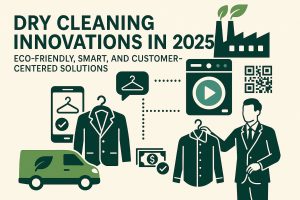Dry Cleaning Innovations in 2026: Eco-Friendly, Smart, and Customer-Centred Solutions
Dry cleaning isn’t just about removing stains anymore. In 2025, the industry is undergoing significant changes. Concerns about the environment, new customer demands, and rapidly evolving technology are driving businesses to improve.
As we explore the latest Dry Cleaning Innovations in 2026, it is clear that the sector is evolving to meet modern needs.
Today, modern dry cleaning focuses on three key aspects: high-quality garment care, sustainable practices, and user-friendly digital services. Features such as plant-based cleaners, water-recycling machines, intelligent quality-control systems, and expedited delivery options are shaping the future.
At Hampstead Garment Care, we’ve been serving our community since 2001. We recognise the importance of keeping up with these changes to provide the best service possible. In this guide, we’ll examine the latest trends of 2025 and their implications for both customers and businesses.
These Dry Cleaning Innovations in 2026 are crucial for maintaining quality service while being environmentally conscious.
Going Green: Eco-Friendly Technologies
Protecting the planet is no longer just a good idea—it’s essential. More customers are concerned about how their clothes are cleaned and are seeking eco-friendly options.
As part of the Dry Cleaning Innovations in 2026, we need to address customer demands for sustainable options.
1. Plant-Based Cleaners
Old chemicals, such as perchloroethylene (also known as “perc”), are being replaced with safe, plant-based solvents. These new cleaners are gentle on clothes, break down naturally, and are environmentally friendly. They are also beneficial for the health of workers who handle cleaning daily, as well as for customers who wear the clothes. These products are derived from natural sources, including corn, citrus, and soy, and they work effectively on a wide range of fabrics while being safer than traditional options.
Example: At Hampstead Garment Care, our eco-friendly cleaners keep clothes soft, fresh, and long-lasting, without releasing harmful toxins. We also educate our customers about how these green solvents help reduce pollution and support a healthier planet, showing that garment care can be both practical and responsible.
Our commitment to Dry Cleaning Innovations in 2026 includes educating customers about eco-friendly cleaners.
2. Saving Water
Washing clothes uses a lot of water, which is a problem in many cities and towns where resources are limited. Traditional wet-cleaning methods can waste thousands of litres a week. New machines today can recycle and reuse water through advanced filtration systems, cutting usage by up to 70%. These machines clean and purify the water, allowing it to be used safely again without compromising the quality of the cleaning process.
These advancements are part of the Dry Cleaning Innovations of 2026, which aim to reduce water consumption significantly.
This not only helps the environment but also reduces costs for both the business and its customers. Some systems even track water usage digitally, allowing cleaners to monitor savings over time and identify areas for improvement.
Real Impact: A busy dry cleaner can save thousands of litres of water every month, which is equivalent to the amount of water several households use in the same period.
3. Using Less Energy
Utilising energy-efficient technologies is one of the Dry Cleaning Innovations in 2026 that allows businesses to save costs.
Modern machines are designed to use less electricity by using efficient motors, better heating systems, and innovative technology that adjusts cycles based on the type of load. Some even run automatically when energy demand is lower, helping businesses save money and reduce their environmental impact. This means dry cleaners can cut their power bills while lowering their carbon footprint. These machines can also be connected to apps or digital tools to track energy usage and identify additional ways to save.
4. Reducing Waste
Eco-friendly dry cleaners now use a variety of strategies to cut down on waste and encourage customers to do the same:
By adopting these Dry Cleaning Innovations in 2026, we can effectively reduce waste and promote sustainability.
-
- Reusable garment bags instead of plastic, which helps prevent single-use plastic waste
- Biodegradable hangers that break down naturally, reducing long-term landfill impact
- Programs to recycle old clothes, keeping fabrics and materials in use rather than being thrown away
- Encouraging customers to return hangers or bags for reuse
The concept of Dry Cleaning Innovations in 2026 is not just about cleaning but also about fostering a greener planet.
- Offering discounts or incentives for customers who participate in recycling efforts
These changes help reduce trash, conserve resources, and demonstrate to customers that a business genuinely cares about the planet and community well-being. Over time, this builds trust and loyalty while making a measurable environmental difference.
Smarter Cleaning with Technology
Incorporating Dry Cleaning Innovations in 2026 ensures a more innovative approach to garment care.
Technology is constantly changing how dry cleaners operate. Automation and artificial intelligence (AI) are making cleaning faster, more accurate, and more reliable by reducing human error, streamlining processes, and providing staff with better tools. These innovations include intelligent machines that learn from past cleaning experiences, apps that connect machines to managers, and sensors that enable automatic decision-making, resulting in higher-quality and more consistent service for customers.
1. Smart Sorting Systems
New machines can quickly determine the type of fabric an item is made of and its level of dirtiness. This helps ensure every piece receives the correct cleaning method. Some systems even use cameras and special scanners to read labels, detect colours, and identify different stains, like oil or wine. This technology helps prevent damage to delicate garments and saves time for workers, ensuring customers get better results.
Example: A silk dress is flagged for delicate cleaning, while a wool coat gets a deep clean and pressing—all done automatically. In a busy shop, hundreds of items can be sorted this way each day, making the process faster and more accurate.
2. AI Quality Checks
Implementing Dry Cleaning Innovations in 2026 can help avoid common mistakes in garment handling.
Cameras and sensors monitor clothes as they move through the cleaning process, capturing detailed images of each item. If they detect a missed stain, a wrinkle, or even signs of fabric damage, staff are alerted immediately so the issue can be addressed. These systems maintain a digital record of quality checks, enabling managers to track performance and refine processes over time. This helps ensure that garments meet the highest standards before they are returned to customers.
3. Robots for Repetitive Tasks
Robots can now fold, press, and package clothes, and they can even sort garments into different categories ready for pickup. Some advanced robots can work alongside humans on complex tasks, learning patterns and improving over time. This speeds up the process, reduces mistakes, and lets staff focus on helping customers, handling special garments, and providing personalised services. These machines are particularly beneficial during peak seasons, when large volumes of clothes need to be processed.
4. Data and Planning
These Dry Cleaning Innovations in 2026 can also enhance operational efficiency and customer satisfaction.
AI tools can predict busy periods, such as wedding season, holidays, or special events, enabling businesses to plan with the optimal number of staff and resources. These tools can also track customer habits, preferred services, and peak delivery times, allowing the managers to make more informed decisions. This keeps operations smooth, reduces wasted effort, and ensures that customers receive fast and reliable service even during the busiest periods.
Better Service for Customers
Modern customers want more than just clean clothes. They expect convenience, clear communication, and personalised service.
Understanding the dry cleaning innovations of 2026 is key to delivering exceptional customer service.
1. Mobile Apps and Online Booking
Easy-to-use apps make dry cleaning a convenient and straightforward process. Customers can:
-
- Schedule pickups and deliveries with just a few taps, saving time
- Pay securely without cash using digital wallets or cards
- Track their order in real time and get notifications about its progress
Adapting to dry cleaning innovations in 2026 enables businesses to meet the evolving expectations of their consumers.
- Get tips for garment care and personalised recommendations based on past orders
- Contact customer support directly through the app for quick help and answers
2. Tracking with QR Codes
Every item is assigned a QR code or chip, serving as a digital identification tag. Customers can scan it using their smartphone or the cleaner’s app to see exactly where their clothes are in the cleaning process. This might include updates on the garment’s status, such as when it was checked in, cleaned, pressed, packaged, and ready for delivery or pickup. This level of detail fosters trust, enhances transparency, and demonstrates accountability, ultimately helping customers feel more connected to the service.
With Dry Cleaning Innovations in 2026, tracking garments has never been easier or more secure.
3. Digital Payments and Rewards
Contactless payments are now standard, making transactions quick and secure for both customers and staff. Many apps also offer rewards, points, or discounts to repeat customers, encouraging loyalty and providing a reason for people to keep coming back. These programs can include birthday rewards, referral bonuses, and special discounts during holidays or slow seasons. Some services even allow users to track their savings over time, view exclusive promotions, and redeem digital coupons directly within the app. This makes the payment process not just convenient but also engaging, adding extra value to every visit and creating a stronger bond between the business and its customers.
4. Pickup and Delivery
Fast delivery is now expected, especially in busy cities like London. Customers want the convenience of having their clothes picked up from their home or office and returned quickly without any hassle. Some businesses even use electric vans or bicycles to make deliveries, combining convenience with eco-friendly practices. Many cleaners now offer same-day or express delivery options, real-time tracking through apps, and flexible scheduling, allowing customers to choose exact pickup and drop-off times. This level of service has become a key way for businesses to stand out in a competitive market.
Fast and reliable service is a key part of the Dry Cleaning Innovations that customers have come to expect in 2026.
How Sustainable Fashion Affects Dry Cleaning
The move toward sustainable fashion means people are buying fewer, higher-quality clothes made with eco-friendly materials and produced using ethical methods. These garments need special care to last longer, which changes how dry cleaners operate. Customers are seeking cleaners who understand the care of delicate fabrics, unique textures, and sustainable manufacturing, and who can guide how to maintain these items over time. This shift also encourages more education, as dry cleaners share tips on garment longevity and promote responsible fashion choices to help reduce waste.
As we shift towards sustainable fashion, dry cleaning innovations in 2026 must adapt accordingly.
1. Gentle Cleaning for Special Fabrics
Materials like organic cotton, bamboo, and recycled fabrics need extra care because they can shrink, lose colour, or wear out faster if cleaned incorrectly. Dry cleaners who understand these fabrics are in high demand, as they use gentle, specialised techniques and eco-friendly solutions to preserve the quality and feel of these garments. This includes using lower temperatures, special detergents, and careful handling during every step of the process.
2. Repairs and Alterations
As people keep their clothes longer, repair services such as mending and tailoring are becoming increasingly popular. This includes fixing torn seams, replacing zippers, resizing garments, and updating older clothes to fit modern styles. Offering these services helps reduce waste and gives customers a way to extend the life of their favourite pieces while supporting sustainable fashion.
Repair and alteration services are part of the Dry Cleaning Innovations in 2026 that enhance garment longevity.
3. Working with Fashion Brands
Some cleaners now partner with eco-friendly clothing brands to offer exceptional care services like proper washing instructions, custom garment care guides, and joint marketing programs. This helps build strong relationships and adds value for customers by ensuring that garments are cared for exactly as the designers intended. These partnerships may also include events, educational campaigns about sustainable fashion, and co-branded loyalty programs, which can increase visibility for both the cleaner and the fashion brand.
Challenges and Opportunities
Despite challenges, the dry cleaning innovations of 2026 offer numerous growth opportunities.
While these changes bring growth and exciting new opportunities for businesses and customers, they also present a variety of challenges that must be carefully managed. Companies need to plan, invest, and adapt to stay ahead of the curve and capitalise on these trends while overcoming obstacles along the way.
1. High Costs
New machines and technologies are expensive, and many small businesses may struggle to afford them initially. These costs include not only the purchase of the equipment but also its installation, maintenance, and staff training. Luckily, some governments offer funding, grants, and tax incentives to help businesses make eco-friendly upgrades, making it easier for them to modernise their operations and compete in a changing market.
2. Training Staff
Advanced machines need skilled workers who understand both the technology and the fabrics they are working with. Companies must train staff to use these tools properly through regular workshops, hands-on demonstrations, and safety courses. Ongoing training also helps employees stay updated on new features, troubleshooting techniques, and customer service skills, ensuring a higher level of quality and safety across the business.
3. Following the Rules
New environmental laws are stringent and continually evolving as governments prioritise reducing pollution and protecting natural resources. Businesses must stay compliant by carefully monitoring their chemical use, waste disposal, and energy consumption to avoid fines and maintain a good reputation. Regular audits, proper record-keeping, and training sessions for staff help ensure that everyone understands the latest regulations and how to follow them correctly.
Compliance with new laws is a key priority for Dry Cleaning Innovations in 2026, which must be a top priority for businesses.
4. Rising Expectations
As technology improves, customers expect faster, better service with more personalisation and transparency. They want easy booking, real-time updates, and exceptional results. Businesses must continually improve by adopting new tools, training their staff, and responding to customer feedback to stay competitive and meet the rising expectations of their customers.
Conclusion: The Future of Dry Cleaning
Eco-friendly methods, innovative technology, and enhanced customer service characterise the dry cleaning world of 2026. From plant-based cleaners to AI-powered machines, every part of the process is improving.
The ongoing evolution of Dry Cleaning Innovations in 2026 reflects our commitment to sustainability and service excellence.
For customers, this means cleaner, safer, and more sustainable care for their clothes. For businesses, it’s an opportunity to stand out by offering innovative and reliable services.
At Hampstead Garment Care, we are proud to embrace these Dry Cleaning Innovations in 2026.




No comment